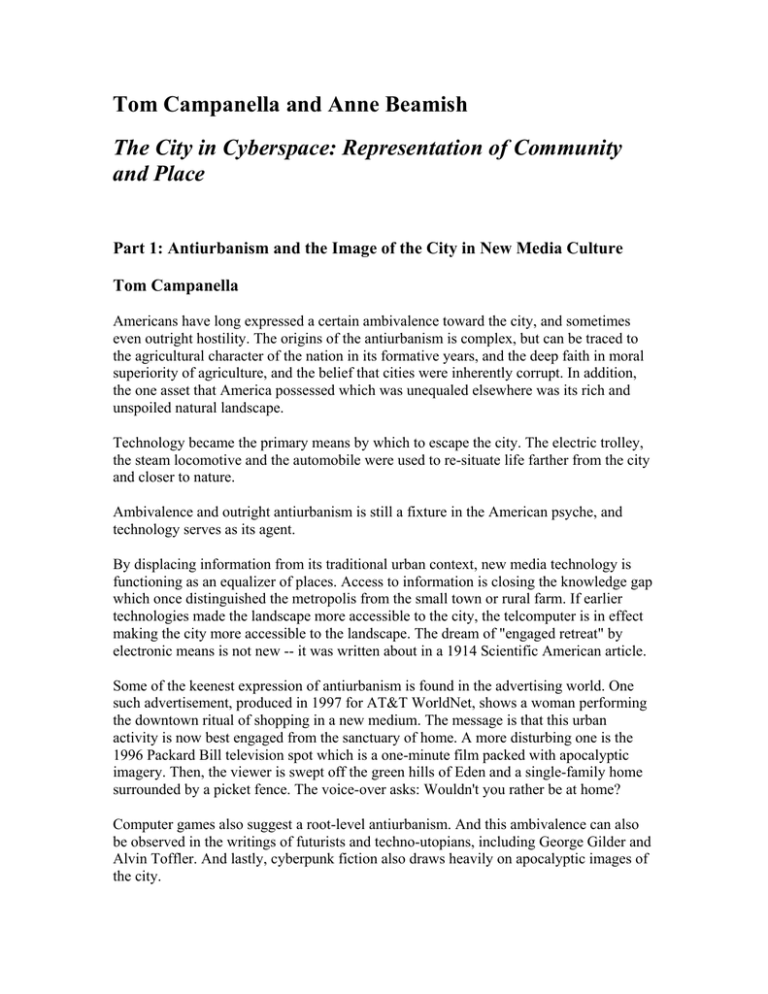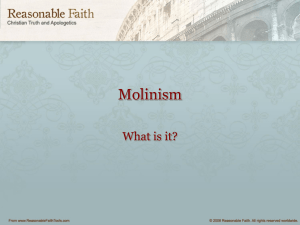Tom Campanella and Anne Beamish and Place
advertisement

Tom Campanella and Anne Beamish The City in Cyberspace: Representation of Community and Place Part 1: Antiurbanism and the Image of the City in New Media Culture Tom Campanella Americans have long expressed a certain ambivalence toward the city, and sometimes even outright hostility. The origins of the antiurbanism is complex, but can be traced to the agricultural character of the nation in its formative years, and the deep faith in moral superiority of agriculture, and the belief that cities were inherently corrupt. In addition, the one asset that America possessed which was unequaled elsewhere was its rich and unspoiled natural landscape. Technology became the primary means by which to escape the city. The electric trolley, the steam locomotive and the automobile were used to re-situate life farther from the city and closer to nature. Ambivalence and outright antiurbanism is still a fixture in the American psyche, and technology serves as its agent. By displacing information from its traditional urban context, new media technology is functioning as an equalizer of places. Access to information is closing the knowledge gap which once distinguished the metropolis from the small town or rural farm. If earlier technologies made the landscape more accessible to the city, the telcomputer is in effect making the city more accessible to the landscape. The dream of "engaged retreat" by electronic means is not new -- it was written about in a 1914 Scientific American article. Some of the keenest expression of antiurbanism is found in the advertising world. One such advertisement, produced in 1997 for AT&T WorldNet, shows a woman performing the downtown ritual of shopping in a new medium. The message is that this urban activity is now best engaged from the sanctuary of home. A more disturbing one is the 1996 Packard Bill television spot which is a one-minute film packed with apocalyptic imagery. Then, the viewer is swept off the green hills of Eden and a single-family home surrounded by a picket fence. The voice-over asks: Wouldn't you rather be at home? Computer games also suggest a root-level antiurbanism. And this ambivalence can also be observed in the writings of futurists and techno-utopians, including George Gilder and Alvin Toffler. And lastly, cyberpunk fiction also draws heavily on apocalyptic images of the city. In conclusion, in spite of the antiurbanism of new media culture, the physical city is in no danger of obsolescence. If anything, the technology has caused cities to flourish. Even as digitization displaces banks, bookstores and record shops, it has triggered the revitalization of whole urban districts. Part 2: Digital Worlds: Pro-urbanism and the Image of the City Anne Beamish Not only have we had a profoundly dark view of urban life, but associated with it has been a long history of lamenting the loss of community. The literature describes a picture of repeating community breakdowns from the 1650s until present day. Part of the reason that we lament the demise of community is because we desire it so much. Our image of the city may be dark, but alongside it runs an equally deep vein of optimism, confidence and belief in not only our need for urban life but our ability to create it. The drive to create new cities continues, and digital technology has given us a new medium with which to experiment and build new worlds. Because one of the principle characteristics of digital technology is that it is profoundly antispatial, it's surprising how often digital worlds incorporate space, either metaphorically or literally. This may seem counterintuitive, but the reason for this has to be due at least in part to the fact that we are physical and spatial creatures. Digital worlds are defined here for the purpose of this paper as interactive, on-line, multiuser environments that emphasize social interaction, let participants decide on selfrepresentation, and permit users to create objects. They typologies of virtual worlds are surprisingly similar to those of public space -- both are usually ategorized by either appearance or use. Graphical worlds are the most rewarding to examine how they represent and reflect our images of community, public space, and the city. The designers seems to approve of cities, and they seem to approve of the physical environment because buildings and streets are painstakingly re-created. But too often they take the image of the city but strip it of its meaning. The downtown is held up to us but is kept out of reach. How successful are they as public places? They have many of the characteristics of physical public spaces. Are they virtual communities? That depends on how you define community. These worlds bring urban design issues to the forefront. Much could be learned and adapted from the physical world that would make them more enjoyable and fulfilling places to be. We should take these worlds seriously, but not too seriously. They are very young and they are still at a very early stage of development. Discussion, Comments, Questions Q: This is powerful stuff (Deuxième Monde) because you can begin to find places that have value, land value. A: And there is variation in value; there are some places in Deuxième Monde, for example that charge thousands of dollars more because they're considered prime real estate. The best places in the real world reflect the best places in the digital world. Q: As soon as you have a commerce model, then you have a way of relating the digital world to the real world in a way that makes sense. What are the people who participate in digital worlds not doing in the real world? What are the demographics? A: It varies. Some people spend an enormous amount of time in these worlds while other only visit for short periods. There are few statistics -- many owners don't make that information public, probably because they can gain advertising dollars if the numbers are high. For example, Alphaworld claims to have 300,000 inhabitants, but it's rare to have more than a dozen there at a time. Q: The people with the more elaborate avatars, who are they and who do they talk to? A: That too varies, but there's a tendency for them to talk to each other. First, because they may be familiar with each other. Second, because many of the newcomers are struggling trying to figure out how their avatar moves and speaks, so they may spend less conversing, and more time learning about the software and the world they've entered. Q: How to they converse? A: All the conversation takes place on the screen. Actually, it can be confusing because in Alphaworld, you can follow conversations that are really miles away from where you are. Q: I was struck by the similarity with other technologies, such as the postal system which allowed people to communicate with each other over long distances. But I would like to talk about the concept of arcadia and the middle landscape, and they all suffer from the fact that there is no dimension of time. Arcadia is a perfect spot, but there is no time. In the virtual world where is this sense of time? A: There are two aspects about time in the virtual world. In one sense it maps directly to real-time. For example, if you go there early in the morning, you'll find few people, but later in the day and especially at night, there will be far more people. There is another aspect of time that programmers often have, and that is of "persistence." For example, if an avatar puts something down, will it still be there when it comes back? This is both a philosophical and programming issue. Many more worlds are now incorporating it. Relating to time is the issue of change, and avatars, which is one of the most destructive things when it comes to encourages social interaction, because avatars can change so fast and so easily, it's not always clear if you're talking to the same person, which results in very shallow conversation. Q: Are there examples in these digital worlds of more critical environments, or a critique of contemporary society? Alphaworld is very different than Alphaville. A: There hasn't been much development in this area. The creators of Alphaworld take their name from Alphaville. Q: I'm interested in accountability, responsibility, and behavior modification in cyberspace. There are rules in the real world and things don't work as well without rules. There are consequences in the real world. Is there such a thing as anti-social behavior. A: There is a police force in Alphaworld, that started up, to fight against the anarchy. There is definitely sprawl in cyberspace. There are fewer rules on the building side, but on the social side, there is a lot of effort that goes into deciding on rules and finding adequate punishment. Q: What are some of the negative aspects of this technology? A: Some of these worlds are like gated communities, but unlike real-world one, it's not as intentional. But they are gated in the sense that you need special software, you need the equipment, you need to know how to operate it, you need good connections, and you need time. These views are also not diverse multi-cultural views. Q: There's a big difference between these social worlds and ones with more purpose, yet you can image something in-between. A: It's true, the worlds so far have been divided into those that provide large amounts of information and those that focus on social interaction. There's been little experimenting combining the two. Q: I was struck by the two images of eWorld and Pope Sixtus's engraving of Rome -- and the triviality of the images shown. A: It's true, the images are rather crude in many ways. Part of the reason is that the creators may not take the image that seriously. And secondly, there is the technical issue of the difficulty showing the detail. There is another difference between the two. EWorld used the metaphor of the city to make abstract information more accessible. And finally the graphic designer who did eWorld had a sophisticated grasp of art and history, and was definitely done tongue-in-cheek. Q: Why should people who interested in cities be at all concerned with the implications of this? A: In the Friday Digital Cities symposium, there was a demo of a project, a digital world, that showed the physical environment of a cancer treatment ward where patients could come and talk. Maybe the question is, is this the very beginning of something important, that is only now seen in a very trivialized way. Q & A: How do these images affect physical space? I can't believe that it won't make a difference and affect the design of physical space. It has to make a difference. Expand that cancer ward project to the level of the city, and it can't help but affect urban form. Respondent: William Mitchell There's been a tremendous amount of discussion in the popular press about some of these issue we've been talking about today, many of which are data-free, so it's worthwhile to have sophisticated observers to pay attention to this. There are major transformations going on and its not clear where they will lead. And the only way we're going to figure it out is by close and sophisticated observation. One thing that came through clearly in the papers is as we've seen new waves of technology, they have been used, before their affordances were known, for the reinvention of ancient dreams. For example, the Arcadian dream is pursued every time a new technology comes along. They have been used to escape the city as well as embracing it. The thing about this technology is that can encompass mutual and contradictory projections easily. Another recurrent theme is the idea of engagement and retreat, and one that is seen in other contexts. For example, Robert Louis Stevenson isolated himself in the South Pacific, but he was able to continue as an extremely successful writer because of the postal service. There is a coming together of some rather traditional ideas about urban quality and the locational freedom that has resulted from telecommunications technology. I would not be fooled by the awfulness of these digital worlds. What we are seeing are the early and primitive explorations of what these online environments are about. And many things that we say are new, when they are not. Avatars are very close to what happens in Mardi Gras. It's a different use of public space. Let me conclude by saying that once you start constructing these large-scale worlds, what starts to happen is that many of the classic questions that urban designers face start to emerge -- e.g. how do you find your way around?






